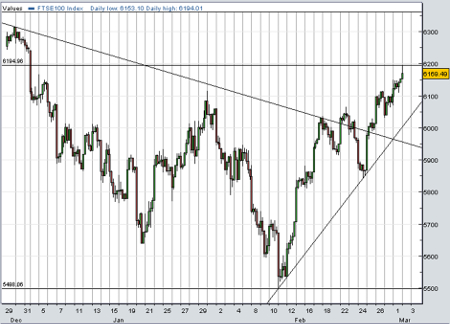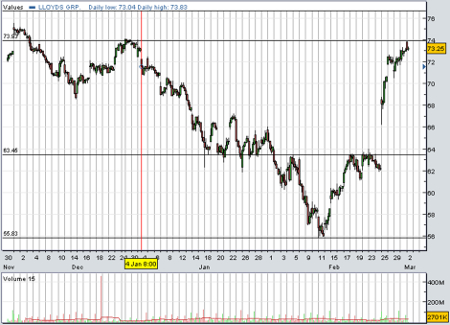Historic day for 'phenomenal' FTSE 100
2nd March 2016 12:03
by Lee Wild from interactive investor
Share on
Finally, investors in the country's largest companies really do have something to cheer, for after two months of heart-stopping volatility, the has traded at its highest level in 2016.
After ending 2015 at 6,242, the blue-chip index started the new year deep in negative territory, losing over 135 points within minutes and triggering what would turn out to be one of the worst starts to a year in living memory.
However, concerns about a slowing Chinese economy, plunging oil prices and rising US interest rates have been put to one side since the market crashed last month to 5,499, the lowest since July 2012.
In less than three weeks, the FTSE 100 has completed perhaps the most remarkable comeback since Ian Botham won the Ashes for England in 1981, rocketing almost 700 points, or 12.6%, to 6,194. It's a perfect example of how investors can never afford to be completely out of the market.
"After the huge global rout that drove most major markets into bear territory, investors' risk appetite is finally beginning to recover, with the VIX trading at its lowest level this year," points out Rebecca O'Keeffe, head of investment at Interactive Investor. "The sharp bounce over the past two weeks has been nothing short of phenomenal - in particular ahead of another key employment report from the US on Friday."

Miners out of a hole
Among the superstar stocks of 2016 is the army of miners, largely blamed for the collapse in the blue-chip index from last April's record high at 7,122. While the Chinese celebrate their year of the monkey, over on the FTSE 100 it's definitely year of the dog!
In 2015, both , down 75%, and , down 70%, were left for dead. In 2016, so far, Anglo is up 67% and Glencore 47%. Regular video contributor and co-founder of Seven Investment Management, Justin Urquhart Stewart, wins the bragging rights after tipping Anglo in December.
And we have the evidence. Justin famously backed Anglo in a video filmed for Interactive Investor when the share price was near 270p. "There will be a turnaround from what has been an awful investment last year, to a more attractive one this year," he said. There has, and the shares are now worth over a fiver!
But which companies helped the FTSE 100 to a 2016 high? Unsurprisingly, Anglo is among the best performers Wednesday, joined by fellow miners , and Glencore.
The banks are back
Banks are in demand again, too. In fact, is top of the blue-chip pile, just a week after it reported a shock $1.5 billion (£1.1 billion) annual loss. However, after plunging close to levels not seen since the previous century, buyers have re-emerged, among them our own John Burford.
On Monday, and with Standard shares at 430p, he suggested a break above the upper wedge line on his charts opened up a move to 800p. "To activate that target, I need to see a rally above the 460p level," he said. The shares nudged 450p Wednesday. You can read John's analysis here.

And, crucially, is in full rally mode (see chart above). Less than three weeks ago the shares could have been bought for just 56p, a near-three-year low and about 24% less than the price at which the government might sell its remaining 9% stake.
"Lloyds bank has reached the magic 73.6p, average government purchase price, for the first time this year," says O'Keeffe. "The slump in share price had caused George Osborne to postpone the proposed sale of their last tranche of Lloyds shares. If the share price stabilises above their breakeven level, this opens the door for the Chancellor to resume the share sale, which would be welcome news for both the Government and prospective investors."
Is the price right?
But after such an astonishing recovery, are UK equities still cheap?
In an attempt to answer the question, Deutsche Bank has analysed the latest global manufacturing purchasing managers' index (PMI) data, often used as a crude estimate of how cheap or expensive equities are.
Equity performance is far more correlated to manufacturing, probably because it's more cyclical and perhaps because in the past it has been seen as a lead indicator, says Deutsche.
Deutsche thinks we'll escape a recession in 2016"Whether it is this time is more open to debate than usual, as the commodity plunge is due mostly to an oversupply in oil rather than a deep fall in demand," admits the broker.
"As such, whilst commodity/manufacturing sensitive economies are likely to be close to or in recession, those with a higher service component could still be saved by the same low commodity price."
However, Deutsche thinks we'll escape a recession in 2016, and points out that the year-on-year declines in equities implies PMIs in the mid-40s, rather than the low-50s which they currently average.
"US equities are high-single-digits % cheap to current data with core Europe 10-20% cheap," it concludes. "There is no disputing that equities look cheap to current manufacturing PMIs even if…most are still slipping, albeit not at an alarming rate."
This article is for information and discussion purposes only and does not form a recommendation to invest or otherwise. The value of an investment may fall. The investments referred to in this article may not be suitable for all investors, and if in doubt, an investor should seek advice from a qualified investment adviser.